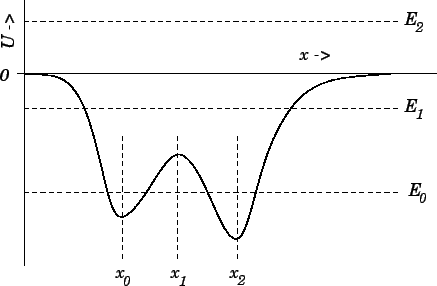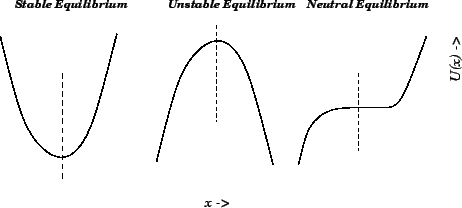


Next: Power
Up: Conservation of energy
Previous: Hooke's law
Motion in a general 1-dimensional potential
Suppose that the curve  in Fig. 43 represents the potential
energy of some mass
in Fig. 43 represents the potential
energy of some mass  moving in a 1-dimensional conservative force-field.
For instance,
moving in a 1-dimensional conservative force-field.
For instance,  might represent the gravitational potential energy
of a cyclist freewheeling in a hilly region. Note that we have set the
potential energy at infinity to zero. This is a useful, and quite common, convention (recall that
potential energy is undefined to within an arbitrary additive constant).
What can we deduce about the motion of the mass in this potential?
might represent the gravitational potential energy
of a cyclist freewheeling in a hilly region. Note that we have set the
potential energy at infinity to zero. This is a useful, and quite common, convention (recall that
potential energy is undefined to within an arbitrary additive constant).
What can we deduce about the motion of the mass in this potential?
Figure 43:
General 1-dimensional potential
 |
Well, we know that the total energy,  --which is the sum of the kinetic
energy,
--which is the sum of the kinetic
energy,  , and the potential energy,
, and the potential energy,  --is a constant of the motion.
Hence, we can write
--is a constant of the motion.
Hence, we can write
 |
(170) |
Now, we also know that a kinetic energy can never be negative, so the above
expression tells us that the motion of the mass is restricted to the
region (or regions) in which the potential energy curve  falls
below the value
falls
below the value  . This idea is illustrated in Fig. 43.
Suppose that the total energy of the system is
. This idea is illustrated in Fig. 43.
Suppose that the total energy of the system is  . It is clear, from
the figure, that the mass is trapped inside one or other of the two dips
in the potential--these dips are
generally referred to as potential wells.
Suppose that we now raise the energy to
. It is clear, from
the figure, that the mass is trapped inside one or other of the two dips
in the potential--these dips are
generally referred to as potential wells.
Suppose that we now raise the energy to  . In this
case, the mass is free to enter or leave each of the potential wells, but
its motion is still bounded to some extent, since it clearly cannot move off to
infinity. Finally, let us raise the energy to
. In this
case, the mass is free to enter or leave each of the potential wells, but
its motion is still bounded to some extent, since it clearly cannot move off to
infinity. Finally, let us raise the energy to  . Now the
mass is unbounded: i.e., it can move off to infinity. In systems
in which it makes sense to adopt the convention that the potential
energy at infinity is zero, bounded systems are characterized
by
. Now the
mass is unbounded: i.e., it can move off to infinity. In systems
in which it makes sense to adopt the convention that the potential
energy at infinity is zero, bounded systems are characterized
by  , whereas unbounded systems are characterized by
, whereas unbounded systems are characterized by  .
.
The above discussion suggests that the motion of a mass moving in a potential
generally becomes less bounded as the total energy  of the system increases.
Conversely, we would expect the motion to become more bounded as
of the system increases.
Conversely, we would expect the motion to become more bounded as  decreases.
In fact, if the energy becomes sufficiently small, it appears likely that the
system will settle down in some equilibrium state in which the mass is stationary.
Let us try to identify any prospective equilibrium states in Fig. 43.
If the mass remains stationary then it must be subject to zero force (otherwise
it would accelerate). Hence, according to Eq. (164), an equilibrium
state is characterized by
decreases.
In fact, if the energy becomes sufficiently small, it appears likely that the
system will settle down in some equilibrium state in which the mass is stationary.
Let us try to identify any prospective equilibrium states in Fig. 43.
If the mass remains stationary then it must be subject to zero force (otherwise
it would accelerate). Hence, according to Eq. (164), an equilibrium
state is characterized by
 |
(171) |
In other words, a equilibrium state corresponds to either a maximum
or a minimum of the potential energy curve  . It can
be seen that the
. It can
be seen that the  curve shown in Fig. 43 has
three associated equilibrium states: these are located at
curve shown in Fig. 43 has
three associated equilibrium states: these are located at
 ,
,  , and
, and  .
.
Let us now make a distinction between stable equilibrium points
and unstable equilibrium points. When the system is slightly
perturbed from a stable equilibrium point then the resultant force  should always be such as to attempt to return the system to this point.
In other words, if
should always be such as to attempt to return the system to this point.
In other words, if  is an equilibrium point, then we require
is an equilibrium point, then we require
 |
(172) |
for stability: i.e., if the system is perturbed to the right, so that  ,
then the force must act to the left, so that
,
then the force must act to the left, so that  , and vice versa.
Likewise, if
, and vice versa.
Likewise, if
 |
(173) |
then the equilibrium point  is unstable. It follows, from
Eq. (164), that stable equilibrium points are
characterized by
is unstable. It follows, from
Eq. (164), that stable equilibrium points are
characterized by
 |
(174) |
In other words, a stable equilibrium point corresponds to a minimum
of the potential energy curve  . Likewise, an unstable
equilibrium point corresponds to a maximum of the
. Likewise, an unstable
equilibrium point corresponds to a maximum of the  curve. Hence,
we conclude that
curve. Hence,
we conclude that  and
and  are stable equilibrium points,
in Fig. 43, whereas
are stable equilibrium points,
in Fig. 43, whereas  is an unstable equilibrium point.
Of course, this makes perfect sense if we think of
is an unstable equilibrium point.
Of course, this makes perfect sense if we think of  as
a gravitational potential energy curve, in which case
as
a gravitational potential energy curve, in which case  is
directly proportional to height. All we are saying is that it is
easy to confine a low energy mass at the bottom of a valley,
but very difficult to balance the same mass on the top of
a hill (since any slight perturbation to the mass will cause it
to fall down the hill). Note, finally, that if
is
directly proportional to height. All we are saying is that it is
easy to confine a low energy mass at the bottom of a valley,
but very difficult to balance the same mass on the top of
a hill (since any slight perturbation to the mass will cause it
to fall down the hill). Note, finally, that if
 |
(175) |
at any point (or in any region) then we have what is known as a neutral equilibrium
point. We can move the mass slightly off such a point and it will still
remain in equilibrium (i.e., it will neither attempt to return to
its initial state, nor will it continue to move). A neutral equilibrium point
corresponds to a flat spot in a  curve. See Fig. 44.
curve. See Fig. 44.
Figure 44:
Different types of equilibrium
 |



Next: Power
Up: Conservation of energy
Previous: Hooke's law
Richard Fitzpatrick
2006-02-02

![]() --which is the sum of the kinetic
energy,
--which is the sum of the kinetic
energy, ![]() , and the potential energy,
, and the potential energy, ![]() --is a constant of the motion.
Hence, we can write
--is a constant of the motion.
Hence, we can write
![]() of the system increases.
Conversely, we would expect the motion to become more bounded as
of the system increases.
Conversely, we would expect the motion to become more bounded as ![]() decreases.
In fact, if the energy becomes sufficiently small, it appears likely that the
system will settle down in some equilibrium state in which the mass is stationary.
Let us try to identify any prospective equilibrium states in Fig. 43.
If the mass remains stationary then it must be subject to zero force (otherwise
it would accelerate). Hence, according to Eq. (164), an equilibrium
state is characterized by
decreases.
In fact, if the energy becomes sufficiently small, it appears likely that the
system will settle down in some equilibrium state in which the mass is stationary.
Let us try to identify any prospective equilibrium states in Fig. 43.
If the mass remains stationary then it must be subject to zero force (otherwise
it would accelerate). Hence, according to Eq. (164), an equilibrium
state is characterized by
![]() should always be such as to attempt to return the system to this point.
In other words, if
should always be such as to attempt to return the system to this point.
In other words, if ![]() is an equilibrium point, then we require
is an equilibrium point, then we require

